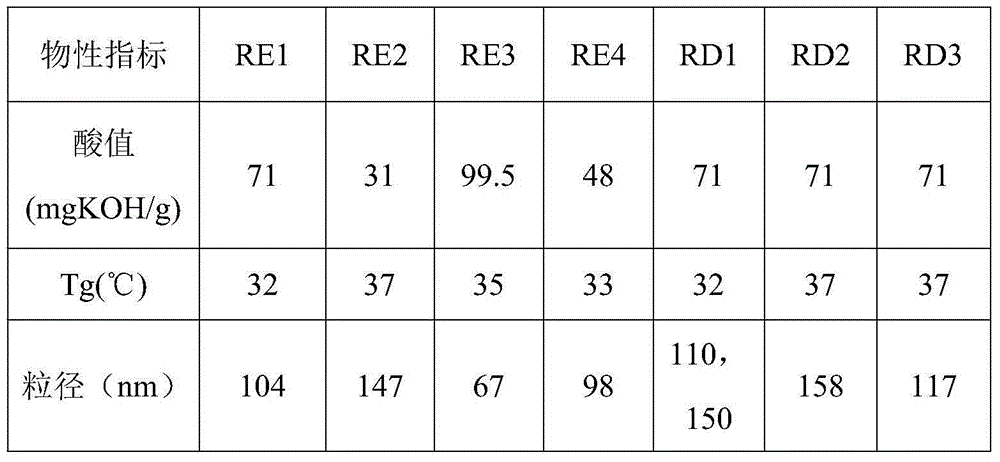Resin for water-based ink as well as preparation method and application of resin
A water-based ink and resin technology, applied in the field of ink manufacturing, can solve the problems of improving gloss and image bleeding, and achieve excellent storage stability and scratch resistance, excellent gloss, good water resistance and adhesion Effect
- Summary
- Abstract
- Description
- Claims
- Application Information
AI Technical Summary
Problems solved by technology
Method used
Image
Examples
preparation example Construction
[0038] 1. Preparation of water-based ink
[0039] Prepare water-based ink according to the general method in this industry, use the ink resin prepared by the present invention as the binder of the pigment, 1,2-hexanediol, 3-ethylene glycol monobutyl ether as the penetrating agent, and glycerin as the wetting agent , 1-methyl-2-pyrrolidone as a dissolution stabilizer, carbon black as a pigment, and deionized water as a solvent.
[0040] Preparation method: Add each component of the formula in Table 1 into the container in turn, stir and mix with an electric stirrer (rotating speed: 200r / min) for 12 hours, and then let it stand for 2 hours. Filter with a membrane filter with a pore size of 5.5 μm to remove impurities such as dust or coarse particles, measure the pH of the system with a pH meter, and adjust the pH between 8.0 and 9.5 with triethanolamine. It should be noted that all the numerical values in Table 1 are expressed in mass %, and deionized water was added so that ...
Embodiment 1
[0077] (1) Add polyoxyethylene ether ammonium sulfate (chemical trade name: LATEMUL PD-104) emulsifier aqueous solution 10.7g (weight solid content 20.6wt%, Japan Kao) in 43g deionized water, 6.2g isooctyl thioglycolate, While stirring, add 72.4 g of methyl methacrylate and 27.6 g of methacrylic acid for emulsification to obtain monomer emulsified dispersion A;
[0078] (2) In the glass reactor (Shanghai Heqi Glass Instrument Co., Ltd.) equipped with a reflux condenser, a separatory funnel, a thermometer, and a nitrogen pipe, add 220.0 g of deionized water and 0.05 g of ammonium bicarbonate pH regulator, Heat up to 85°C, add 40g of 5% ammonium persulfate aqueous solution at 85°C, add the monomer emulsion dispersion A of step (1) into the reactor with a plunger pump (Tokyo Physical and Chemical VSP-1050) after 1 minute, After 2 hours of dropping, continue to react for 0.5 hours after the dropping, add ammonia water with a weight concentration of 15% to the reactor, adjust the p...
Embodiment 2
[0081] Add 0.5 g of polyoxyethylene alkyl ether (chemical trade name: LATEMUL PD-420) emulsifier and 4.0 g of isooctyl thioglycolate into 43 g of deionized water, and add 87.68 g of methyl methacrylate and methacrylic acid while stirring. 12.32 g was emulsified to obtain monomer emulsified dispersion liquid A.
[0082] Add 220 g of deionized water and 0.05 g of ammonium bicarbonate pH regulator to a glass reactor (Shanghai Heqi Glass Instrument Co., Ltd.) equipped with a reflux condenser, a separatory funnel, a thermometer, and a nitrogen pipe, and heat up to 85 ° C. Add 30 g of 5% ammonium persulfate aqueous solution at 85° C., and add the monomer emulsified dispersion A in the early stage into the reactor with a plunger pump (Tokyo Physical and Chemical VSP-1050) after 1 minute. After 0.5 hours, dropwise add Continue the reaction for 1.5 hours after completion, add ammonia water with a weight concentration of 22% in the reactor to adjust the pH to 8.0g, and keep it warm for ...
PUM
| Property | Measurement | Unit |
|---|---|---|
| size | aaaaa | aaaaa |
| density | aaaaa | aaaaa |
| acid value | aaaaa | aaaaa |
Abstract
Description
Claims
Application Information
 Login to View More
Login to View More - R&D
- Intellectual Property
- Life Sciences
- Materials
- Tech Scout
- Unparalleled Data Quality
- Higher Quality Content
- 60% Fewer Hallucinations
Browse by: Latest US Patents, China's latest patents, Technical Efficacy Thesaurus, Application Domain, Technology Topic, Popular Technical Reports.
© 2025 PatSnap. All rights reserved.Legal|Privacy policy|Modern Slavery Act Transparency Statement|Sitemap|About US| Contact US: help@patsnap.com



